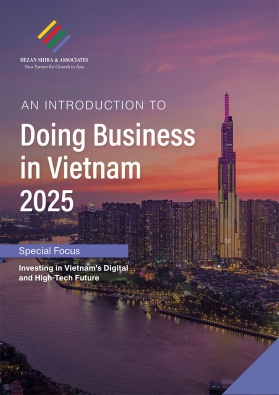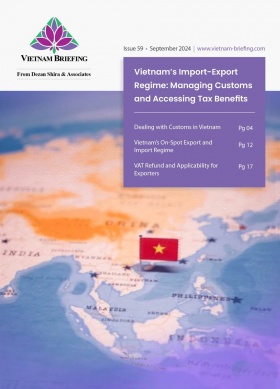Investment Support Fund for High-Tech Enterprises in Vietnam: Decree 182
On December 31, 2024, the Vietnamese Government issued Decree No. 182/2024/ND-CP (“Decree 182”) on the establishment, management, and utilization of the Investment Support Fund. The decree shows Vietnam’s commitment to fostering innovation and establishing itself as a hub for advanced technology.
Decree 182 has been widely praised by experts as a landmark initiative reflecting the government’s commitment to attracting world-class high-tech businesses to invest in Vietnam. The decree establishes the Investment Support Fund (ISF), offering cash grants and subsidies to businesses undertaking eligible investment projects in the country. It outlines clear eligibility criteria, ensuring alignment with Vietnam’s economic development priorities and goals.
Decree 182 came into effect on December 31, 2024, and applies retrospectively from the fiscal year 2024 onward.
Also read: Vietnam’s Digital Infrastructure Master Plan to 2030: Roadmap to a High-Tech Future
How does the Vietnam Investment Support Fund work?
The Investment Support Fund is a national fund established by the Vietnamese Government and managed by the Ministry of Planning and Investment. It operates as a non-profit entity, serving public welfare objectives.
Functions and operations
The ISF functions as a public service unit under the Ministry of Planning and Investment, governed by specific organizational and operational regulations outlined in Decree 182. It holds legal status, operates under its own seal, and maintains budget accounts with the State Treasury for receiving state funds, as well as separate accounts with the State Treasury and commercial banks for non-state budget sources.
Its primary responsibilities include:
- Managing financial resources to support eligible beneficiaries as specified in Decree 182;
- Allocating and utilizing funds in accordance with regulatory guidelines;
- Providing financial assistance to enterprises based on defined conditions and limits; and
- Ensuring compliance with reporting, financial management, accounting, and auditing regulations.
Powers and personnel
The ISF is authorized to:
- Perform activities aligned with its objectives;
- Hire experts and organizations to implement its tasks; and
- Deposit non-state financial resources with commercial banks or the State Treasury.
The fund is managed by a Fund Management Board and a Fund Executive Body. Revenues generated by the ISF are exempt from corporate income tax.
Types funding support provided by Vietnam’s Investment Support Fund
The Investment Support Fund provides two types of financial support: initial investment support and cost support. Eligible businesses may choose only one type of support if they qualify for both.
Initial investment support
Enterprises investing in research and development (R&D) center projects in sectors like semiconductors and artificial intelligence (AI) that meet specific criteria can receive support of up to 50 percent of the project’s initial investment costs or other levels as determined by the government.
Cost support
According to Article 16 of Decree 182, the ISF provides financial aid to businesses for the following costs:
- Training and human resource (HR) development;
- R&D;
- Investment in creating fixed assets;
- Manufacturing of high-tech products;
- Investment in social infrastructure works; and
- Other cases as determined by the Government.
Eligible entities
Entities eligible for cost support under the ISF include:
- High-tech enterprises;
- Enterprises with investment projects in high-tech product manufacturing;
- Enterprises with high-tech application projects; and
- Enterprises with investment projects in R&D centers.
|
Cost Support for Eligible Projects (*) under Vietnam’s Investment Support Fund (Decree 182) |
|
|
Costs |
Support |
|
Training and HR development costs |
Up to 50 percent of the actual expenses for HR development training activities incurred during the fiscal year for Vietnamese employees. |
|
R&D costs |
Based on the actual R&D expenses incurred during the fiscal year, companies will receive support at varying progressive rates, as outlined below:
|
|
Investment costs for forming fixed assets |
Companies will receive support payments at a progressive rate calculated on the historical cost of the newly acquired fixed assets. However, this support will not exceed 0.5 percent of the total investment capital:
|
|
High-tech product manufacturing costs |
|
|
Investment costs for social infrastructure projects |
|
Note: (*) Companies investing in R&D center projects will not be supported for costs related to fixed asset formation and high-tech product manufacturing. Other projects that do not meet the requirements will have to wait for future support as determined by the government.
Principles for applying support policies
Article 3 of Decree 182 establishes the principles governing the application of support policies under the Investment Support Fund. Key principles include:
Cost support principles
Concurrent support: Businesses meeting criteria for multiple cost support categories can receive support for all qualifying categories simultaneously.
Currency and duration: Cost support is provided in Vietnamese Dong (VND) and is available for a maximum of five years per enterprise or project, unless extended by the Prime Minister.
Application period: Support for eligible cost items begins from the financial year in which the high-tech enterprise or project generates revenue and incurs qualifying costs. These costs must fall within the financial year when any of the following certificates are issued:
- Certificate of high-tech enterprise;
- Certificate of high-tech application;
- Certificate of a newly established enterprise from a high-tech product manufacturing project;
- Certificate of high-tech product manufacturing project; and
- Certificate of R&D center project.
Application process: Enterprises must submit their cost support applications after the financial year ends for which the support is sought.
Simultaneous eligibility principle
Enterprises with projects that have obtained investment policy approval, an investment registration certificate (IRC), or equivalent legal documents before or after the effective date of Decree 182 are eligible for ISF support.
If a business qualifies for support from both the ISF and other government funds or programs for the same expense, it must choose only one source of assistance. Support for the same expense cannot be claimed from multiple sources unless explicitly permitted by the Government or the Prime Minister.
Self-responsibility principle
Enterprises are responsible for self-declaring the legality, accuracy, and truthfulness of all data and information submitted in cost support applications. They bear full legal responsibility for their declarations.
Funds received from the ISF are excluded from taxable income for corporate income tax purposes.
Application process to seek investment support under the ISF
Enterprises seeking investment support under the ISF must submit their applications to the designated agency before July 10 of the year following the financial year for which the support is requested.
Once the application is submitted, the request is processed by the fund’s Executive Agency, reviewed by the Fund Management Council, and subsequently evaluated by the Vietnam Government.
The Government is responsible for reviewing and deciding on the total investment support amount allocated to the enterprise.
Conditions to apply for investment support payment
|
Financial Conditions to Apply for Investment Support Payment |
||||
|
|
High-tech enterprises |
Enterprises with investment projects in manufacturing high-tech products |
Enterprises with high-tech application projects |
Enterprises with investment projects in R&D centers |
|
Annual revenue |
|
Non-applicable |
||
|
Capital scale |
|
Minimum VND 3 trillion (US$118 million) |
||
Exemptions from revenue and investment capital criteria
The following companies and projects are exempted from meeting revenue and investment capital criteria under Decree 182:
Companies/projects with high-tech products or technology: Entities involved in products or technology included in the Prime Minister’s list of high-tech fields and high-tech products prioritized for development.
Microchip design projects: Projects in microchip design are exempt, provided they commit to:
- Employing at least 300 Vietnamese engineers and managers within five years of operation in Vietnam; and
- Annually supporting the training of at least 30 Vietnamese engineers in the field of microchip design.
|
Deadlines for Minimum Investment Disbursement under ISF |
||||
|
|
High-tech enterprises |
Enterprises with investment projects in manufacturing high-tech products |
Enterprises with high-tech application projects |
Enterprises with investment projects in R&D centers |
|
Projects granted IRC, Decisions on investment policy approval (IPAD), or Decisions on investor approval (IAD) from the effective date of Decree 182
|
|
To disburse VND 1 trillion within 3 years from the date of investment license issuance.
|
||
|
Investment in the fields of chip manufacturing, semiconductor integrated circuits, or artificial intelligence data centers:
|
||||
|
Projects with registered capital below the minimum of VND 12 trillion before the effective date of this Decree and subsequently adjusted to meet the minimum capital requirement |
Adjustments increasing capital is less than VND 10 trillion:
|
|||
|
Chip production, semiconductor integrated circuit, and AI data center projects with registered capital below the minimum of VND 6 trillion before the effective date of this Decree and subsequently adjusted to meet the minimum capital requirement |
If the adjusted capital increase is less than VND 4 trillion:
|
|||
|
Projects with registered investment capital of at least VND 12 trillion (or VND 6 trillion for chip production, semiconductor integrated circuits, and artificial intelligence data centers) under Certificate of investment |
Projects with IRCs, IPADs, IADs, or other equivalent legal documents issued or adjusted before the effective date of this Decree, but with incomplete disbursement, must:
|
|||
Key takeaways
Businesses must promptly begin evaluations and necessary preparations to qualify for ISF fund support and be prepared to submit their initial applications before the July 2025 deadline. Necessary steps to consider include:
- Review ISF policies carefully: Firms must thoroughly assess the eligibility criteria and conditions to uncover potential advantages your business can gain from this new incentive scheme.
- Identify and address gaps: Companies need to assess their existing qualifications in relation to the eligibility criteria of the new incentive policy, as well as identify any deficiencies that potentially impact their eligibility. Proactive measures, such as applying for High-Tech Certification when applicable, must be taken to ensure compliance and preparedness for these incentives.
- Claim eligible incentives: If confirmed as eligible, businesses must carefully prepare and submit all the necessary documents to claim subsidies from the ISF, as well as keep track of the process to swiftly address any arising issues.
About Us
Vietnam Briefing is one of five regional publications under the Asia Briefing brand. It is supported by Dezan Shira & Associates, a pan-Asia, multi-disciplinary professional services firm that assists foreign investors throughout Asia, including through offices in Hanoi, Ho Chi Minh City, and Da Nang in Vietnam. Dezan Shira & Associates also maintains offices or has alliance partners assisting foreign investors in China, Hong Kong SAR, Indonesia, Singapore, Malaysia, Mongolia, Dubai (UAE), Japan, South Korea, Nepal, The Philippines, Sri Lanka, Thailand, Italy, Germany, Bangladesh, Australia, United States, and United Kingdom and Ireland.
For a complimentary subscription to Vietnam Briefing’s content products, please click here. For support with establishing a business in Vietnam or for assistance in analyzing and entering markets, please contact the firm at vietnam@dezshira.com or visit us at www.dezshira.com
- Previous Article HCMC Metro Planning and Transit-Oriented Development: Opportunities for Foreign Investment
- Next Article Vietnam Seeks Early Accession to the OECD








